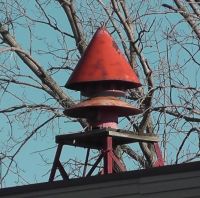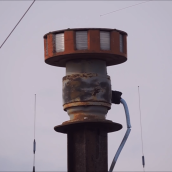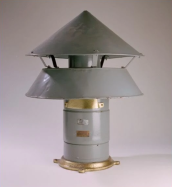Siro-Drone: Difference between revisions
TheCamWheel (talk | contribs) mNo edit summary |
TheCamWheel (talk | contribs) mNo edit summary |
||
| (5 intermediate revisions by the same user not shown) | |||
| Line 17: | Line 17: | ||
=== Type 9 === | === Type 9 === | ||
==== Type | ==== Type 925 ==== | ||
[[File:Siro Drone Type 925.png|thumb|168x168px|A 2.5 hp Siro-Drone Type | [[File:Siro Drone Type 925.png|thumb|168x168px|A 2.5 hp Siro-Drone Type 925, located in Hettick, IL. Image by American Siren Productions.]] | ||
One of the smallest of the Siro-Drones is the '''Type | One of the smallest of the Siro-Drones is the '''Type 925''', which uses a small 8-port rotor and stator, driven by either a 1 or 2.5 horsepower universal motor. These sirens were designed as pole toppers, filling in small coverage gaps or for short range use. These tiny sirens are omnidirectional and also small, being comparable to a [[Federal Signal Corporation|Federal]] [[Federal Signal Model 2|Model 2]] or [[Sterling Siren Fire Alarm Co.|Sterling]] [[Sterling Vertical Siren|2V8]] in size. The siren heavily resembles a downsized version of the 1942 design, with the addition of finger guards on the stator ports to prevent personal injury. | ||
==== Type 93 ==== | ==== Type 93 ==== | ||
Latest revision as of 06:01, 4 November 2024
| Harry O. Ricci Siro-Drone | |
 The infamous "Hula-HOR" 3 hp Siro-Drone in Toledo, OH, known for its rapidly spinning loose housing. It was permanently taken out of service in 2023. | |
| Company | Harry O. Ricci Siren & Signal, Inc. |
|---|---|
| Produced | 1942-1968? |
| Type | Omnidirectional Electromechanical |
| Sound output | - |
| Frequency | 60 Hz |
| Horsepower | 1/8-7.5 hp |
| Succeeded by | H.O.R. Sirex |
The Siro-Drone was a series of small to mid-size vertical omnidirectional sirens designed and produced by H.O.R.'s founder and designer, Harry O. Ricci, out of Staten Island, NY. These were H.O.R.'s first outdoor warning sirens and proved quite successful over the roughly 30 years it was produced. Ranging from tiny pole toppers to medium sized weatherproof sirens, the Siro-Drones were very versatile, and several continue to serve to this day.
History
(This will be expanded upon to include new/recently discovered information.)
The Siro-Drone began production by as early as 1942 and were H.O.R.'s first successful attempt at making an outdoor warning siren larger than a vehicular siren. The Siro-Drone was advertised as a "roaring" siren and was intended to be a competitor to the Fedelcode (and later Model 5) sirens produced by Federal Electric and later Federal Sign & Signal. The sirens were available in a variety of different horsepower ratings and housing styles, and it is unknown exactly how many different variations there were. The Siro-Drone was available in ⅛ hp, 2 hp, 3 hp, 5 hp, and 7.5 hp. These sirens were available in 1 or 3 ph AC, and could use 7, 9, 10, or 12-port single tone rotors and stators.
The Siro-Drone, along with its larger cousins the Sirex and Super Sirex, ended production sometime in the late 1960s, as Ricci retired from the siren business. Several Siro-Drones continue to operate today, despite being discontinued over 60 years ago. Its simple design allows it to be incredibly low maintenance, which allows them to keep roaring. While their time as civil defense sirens have passed, they continue to be used for fire calls, noon blasts, and severe weather warnings.
Design
Most Siro-Drones use a rotor-over-motor configuration, with the intake being located on top. All Siro-Drones use housings with a single skirt to direct the sound from the rotor outwards, while the rain shield on top serves to both protect the siren from the elements and project the siren's intake sound downwards and outwards. Most Siro-Drones are not completely weatherproof, using bare motors exposed to the elements, and the rotor and stator are also often exposed to the elements. Despite this, Siro-Drones were marketed as weatherproof, even in salt air. Some were designed with special weatherproof housings, before switching to a housing design reminiscent of Federal Signal General Alarm Sirens.
Type 9
Type 925

One of the smallest of the Siro-Drones is the Type 925, which uses a small 8-port rotor and stator, driven by either a 1 or 2.5 horsepower universal motor. These sirens were designed as pole toppers, filling in small coverage gaps or for short range use. These tiny sirens are omnidirectional and also small, being comparable to a Federal Model 2 or Sterling 2V8 in size. The siren heavily resembles a downsized version of the 1942 design, with the addition of finger guards on the stator ports to prevent personal injury.
Type 93

The Type 93, was an early weatherproof Siro-Drone design which was 3 hp by default but could be upgraded to 5 (Type 95) or 7.5 (Type 975) hp through special order. The siren used a large cylindrical housing around the motor, rotor and stator, with a rounded skirt directing the siren's output downwards, and a small opening on the top where the siren intakes. A gong-shaped rain shield protects the siren and projects the intake sound outwards. Later in the siren's life, the weatherproof design would be changed to a design extremely similar to Federal's General Alarm Sirens, although the Type 93 is able to be told apart visually by their smaller (or sometimes larger) skirt, and flatter rain shields than Federals.
Type 95
WIP
Type 975
WIP
Siro-Drone (3 hp)

The most peculiar housing design is used on the smaller 3 hp models. This design uses a wide, flat skirt mounted below the 9 or 10-port rotor and stator, with the rain shield being its own separate piece held up by a support attached to the top of the stator. The skirt and rain shield work together to project the siren's intake and rotor sound outwards evenly, however this design has a critical flaw. The rain shield is held on by only a single screw, which can come loose over time due to wear and tear, and the jolt of the siren starting and stopping. Eventually, the rain shield can come loose and begin spinning violently as the siren operates. This will damage the siren and its mount over time, eventually resulting in either the siren being jolted off of its mount, or the rain shield flying off. One such example of this problem is an infamous 3 hp Siro-Drone in Toledo, OH, jokingly nicknamed the "Hula-HOR" by enthusiasts.
Siro-Drone (5 hp/7.5 hp)

The most common style used on Siro-Drones is the original style advertised in 1942. The siren uses a bare 5 or 7.5 hp motor, which drives a 10-port rotor and stator. The siren uses a large skirt attached to the top of the stator, which directs all of the rotor's output downwards, and a large rainshield is attached to the skirt by 4 thin metal rods. The rainshield protects the rotor from the elements, while also directing the sound from the siren's cylindrical intake outwards and downwards. This made the siren ideal for both roof and pole mounting. The motor has a stand attached to it for mounting purposes. Later models use a weatherproof housing that is incredibly similar to a Federal Signal C2 1/2, only with a smaller skirt and shallower rainshield. Some bear heavy resemblance to Thibault sirens as well. This design protected the motor along with everything else, better preserving the siren. These weatherproof housings do not have a unified design, and slightly vary from siren to siren.
Siro-Drone Type 87

The smallest Siro-Drone was a small electric siren designed for industrial use known as the Siro-Drone Type 87. Very similar in appearance to Federal's Model A and D, as well as the Sterling Type F, this model of Siro-Drone uses a 7-port rotor and stator, driven by a high speed ⅛ hp AC/DC universal motor. The Siro-Drone Type 87's internals are housed inside of a rounded motor cover, which is attached to a metal stand by a swivel. The design of this stand is nearly identical to that of Federal's industrial sirens, albeit with a slightly shallower angle at the swivel due to the differing width of the motor cover. The siren's intake is different than any other H.O.R. siren, heavily resembling those used by Sterling's sirens. The intake is conical to a certain point where it then flares back out to the full width of the stator. This pressurizes the air, increasing performance. A large conical projector surrounds the rotor and stator to direct the full output in a single direction. The Siro-Drone Type 87 is designed to be mounted on any flat surface, with four mounting screw holes included on the stand. Interestingly, despite being a small siren, the Siro-Drone Type 87 lacks any sort of protection for the user, with no finger guards or intake screens.